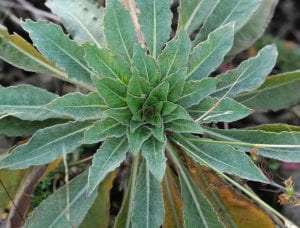Scientific Name: Oenothera biennis
Common Name: evening primrose
Native Range: Eastern North America
Zone: 4 to 9
Plant type & Form: Herbaceous perennial
Height: 3.00 to 5.00 feet
Spread: 2.00 to 3.00 feet
Bloom Time: June to September
Bloom Description: Yellow
Flower: tiffly-upright, rough-hairy, purple-tinged flower stem (usually a single stem but sometimes multiple stems) with spirally arranged leaves rises from the center of the rosette to 3-5’ tall, topped by a showy summer to fall (June to September) bloom of bowl-shaped, four-petaled, lemon yellow flowers (each to 1-2” across)
Fruit: capsules (narrow seed pods to 1 1/2” long) which split open when ripe to release numerous seeds (to 100 seeds per capsule)
Leaf: basal rosette of shallow-toothed, lanceolate, light green to olive green leaves (to 4-8” long and 2” wide)
Sun: Full sun to part shade
Water: Medium
Soil type & pH: Grows well in gravelly or sandy soils.
Maintenance: Medium
Suggested Use: Naturalize
Tolerates: Drought
Notes: Flowers open at dusk and close again in the morning when hit by sun, hence the common name of evening primrose. Flowers are fertilized by night-flying moths which are attracted by the mild lemon flower fragrance and by bees in the early morning before closure.
Identification notes: Look for the yellow flowers that are spirally arranged

Zweyjährige Nachtkerze.


